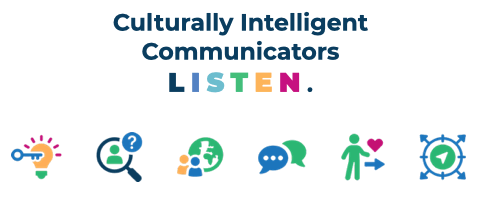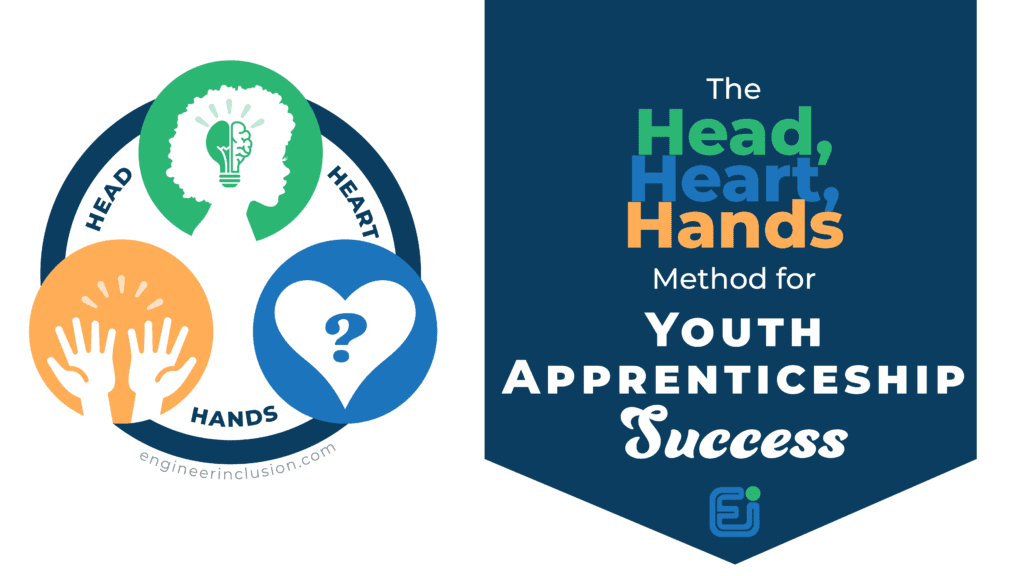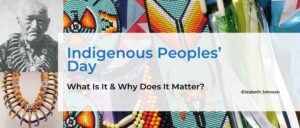In an increasingly interconnected world, the ability to communicate across cultural boundaries is not just a valuable skill—it’s a necessity. But what exactly does it mean to communicate in a culturally intelligent way? And more importantly, how can we develop this skill? This post aims to explore these questions and introduce a practical tool to enhance your intercultural communication skills—the LISTEN framework.
Companion Resource
Download Your Free Guide
Get our free guide to mastering culturally intelligent communication with the LISTEN framework. Includes key definitions, actions, examples, and a reflective planning worksheet. Download now for insightful professional growth.
DownloadCulturally Intelligent Communication is the practice of actively and empathetically engaging in conversations where diverse voices, values, and perspectives are acknowledged and respected. It involves attentively recognizing and addressing the presence, absence, or silencing of various ways of knowing, doing, and being and consciously bridging gaps to foster inclusive and effective interactions among diverse individuals.

Understanding Culturally Intelligent Communication
Culturally intelligent communication doesn’t simply mean speaking another language or knowing about other cultures. It’s about effectively interacting, empathizing, and communicating with people across diverse cultural backgrounds. When we communicate with cultural intelligence, we are aware of our biases, understand and respect other cultural norms and values, and adapt our communication style accordingly.
What is the purpose of Culturally Intelligent Communication?
The purpose of culturally intelligent communication is to foster understanding, respect, and effective collaboration in diverse environments. It aims to bridge cultural gaps, value diverse perspectives, and create an inclusive atmosphere where all voices are heard and respected. By enabling individuals to interact empathetically and knowledgeably across cultural boundaries, culturally intelligent communication enhances mutual understanding, reduces conflicts, and facilitates more effective and harmonious interactions in both personal and professional contexts. Ultimately, it contributes to building more inclusive, equitable, and culturally aware communities and organizations.
Why is Culturally intelligent communication needed?
We need culturally intelligent communication for several crucial reasons, especially in our increasingly interconnected and diverse world:
Globalization and Diversity
As our communities and workplaces become more culturally diverse due to globalization and migration, the ability to communicate effectively across cultural boundaries is essential. Misunderstandings and conflicts often arise from cultural misinterpretations, which culturally intelligent communication seeks to minimize.
Inclusivity and Equity
Culturally intelligent communication fosters inclusive environments where everyone feels valued and understood. It helps recognize and respect diverse perspectives, ensures all voices are heard and contributes to equitable treatment and opportunities.
Enhanced Collaboration and Productivity
Culturally intelligent communication leads to better teamwork and productivity in professional settings. Understanding and valuing diverse viewpoints can spur creativity and innovation, as different perspectives often lead to more comprehensive and effective solutions.
Personal and Professional Growth
Culturally intelligent communication encourages individuals to expand their perspectives and understanding, leading to personal growth and development. It equips individuals with the skills to navigate diverse settings more effectively, making them more adaptable and competent in various roles.
Social Harmony and Conflict Resolution
Culturally intelligent communication plays a critical role in building social harmony by fostering empathy and understanding. It can be instrumental in resolving conflicts and misunderstandings that arise from cultural differences.
Educational Enrichment
In educational settings, such communication enhances the learning experience by incorporating diverse perspectives and teaching styles, more effectively accommodating students from various cultural backgrounds.
Global Citizenship
Culturally intelligent communication is a cornerstone of global citizenship, equipping individuals to interact respectfully and effectively in a global context, and to contribute positively to our interconnected world.
In summary, culturally intelligent communication is vital for navigating the complexities of our diverse societies, creating more inclusive and effective communities and organizations, and fostering global understanding and cooperation.

How do you become a Culturally intelligent communicator? Try the LISTEN Framework
To become a culturally intelligent communicator, you must LISTEN.
LISTEN stands for Learn, Inquire, Synthesize, Translate, Empathize, and Navigate. Each component of this framework is a step towards more effective and empathetic communication in diverse settings. Below, I introduce the LISTEN framework, providing the key action, an example, a reflection prompt, and a planning prompt. Don’t forget to download the handout to help you become a more culturally intelligent communicator.
Learn
Actively learn about different cultural backgrounds, perspectives, and experiences. This involves seeking knowledge and understanding of various cultural norms and values, and ways of knowing, doing, and being.
- ACTION: Seek knowledge about different cultural backgrounds.
- EXAMPLE: A manager learns about Ramadan to support her Muslim employees effectively.
- REFLECT: What cultural knowledge am I missing that could enhance my interactions?
- PLAN: I will read an article or book about a culture I frequently interact with but know little about.
Inquire
Ask insightful and respectful questions to gain a deeper understanding of individual experiences and cultural contexts. Listen to learn, not to respond. Believe people’s experiences and strive to set your ego and intentions aside.
- ACTION: Ask questions to gain deeper insights into individual experiences.
- EXAMPLE: A teacher asks an immigrant student about their education experience in their home country.
- REFLECT: Do I encourage others to share their cultural perspectives? (Without tokenizing people?)
- PLAN: In my next meeting, I will ask a culturally insightful question to understand my colleagues' viewpoints better.
Synthesize
Combine information and insights gathered from diverse sources to form a comprehensive understanding of cultural dynamics in your setting. To have a comprehensive synthesis, you must seek input from key stakeholders.
- ACTION: Combine diverse insights to form a comprehensive understanding.
- EXAMPLE: A healthcare provider synthesizes the cultural practices of different communities to offer better patient care.
- REFLECT: How do I use diverse perspectives in decision-making?
- PLAN: I'll consider how different cultural views can influence the outcome of my next project and plan accordingly.
Translate
Translate understanding and awareness into practical actions and strategies that enhance inclusivity and cultural responsiveness in your setting. Verify your actions, efforts, and strategies, are meeting the needs of marginalized populations.
- ACTION: Apply cultural understanding to enhance inclusivity.
- EXAMPLE: An HR professional updates company policies to be more inclusive of different cultural needs.
- REFLECT: How can I translate my understanding into inclusive actions?
- PLAN: Identify one policy or practice I can change to be more culturally inclusive.
Empathize
Demonstrate empathy by genuinely connecting with and understanding the feelings and perspectives of others, especially those from different cultural backgrounds. Use systemic thinking to identify barriers people may face.
- ACTION: Connect emotionally with people from different backgrounds.
- EXAMPLE: A counselor empathizes with a refugee family by acknowledging their unique challenges.
- REFLECT: When did I last connect deeply with someone from a different culture?
- PLAN: I will converse with someone from a different background and focus on building empathy.
Navigate
Skillfully navigate through complex cultural interactions and situations using adaptive communication strategies and behaviors. Practice authenticity, transparency, and openness. Remember, people need to feel valued, included and heard.
- ACTION: Manage complex cultural interactions effectively.
- EXAMPLE: A diplomat navigates a multi-cultural negotiation by being mindful of cultural nuances.
- REFLECT: How did I handle my last complex cultural interaction?
- PLAN: Develop a strategy for better handling future cultural complexities.
Illustrative Examples
Employing the LISTEN framework in our daily lives can lead to more meaningful conversations, stronger relationships, and a deeper understanding of the diverse world we live in. In professional settings, it enhances teamwork, customer relations, and overall workplace harmony. In personal interactions, it enriches our experiences and broadens our perspectives.
Corporate Team Scenario:
Imagine a team leader in a multinational corporation struggling with cultural misunderstandings within their team. By integrating the ‘Learn’ and ‘Empathize’ components of the LISTEN framework into their communication strategy, imagine how this could improve team efficiency and morale, showcasing the power of culturally intelligent communication in a corporate setting.
Educational Context Scenario:
Consider a classroom where a teacher notices a participation gap among students from diverse backgrounds. If the teacher applies the ‘Inquire’ and ‘Navigate’ aspects of LISTEN to understand and address this issue, it could lead to a more inclusive curriculum and increased student engagement, illustrating the impact of cultural awareness in education.
Healthcare Provider Interaction:
Envision a healthcare scenario where a patient from a different cultural background is hesitant about a treatment plan. A healthcare provider using the ‘Synthesize’ and ‘Translate’ steps could adapt the treatment to align with the patient’s cultural beliefs, improving patient comfort and treatment outcomes. This example highlights the importance of culturally sensitive communication in healthcare.
Non-Profit Outreach Initiative:
In a non-profit setting, challenges in reaching diverse communities might arise. By employing ‘Learn’ and ‘Inquire’ from the LISTEN framework, a non-profit could effectively tailor its outreach efforts, leading to better community engagement and demonstrating the value of cultural intelligence in community services.
Personal Growth and Travel:
On a personal level, using ‘Empathize’ and ‘Navigate’ from the LISTEN framework can enrich travel experiences. This approach allows travelers to deeply connect with people from different cultures, offering a richer understanding of the world, thereby underscoring the personal benefits of culturally intelligent communication.
Reminders for before, during, and after interaction
Pre- Interaction
- Acknowledge that you may hold preconceptions and biases, and set an intention to avoid them.
- Remind yourself of the key principles of empathy (perspective-taking, staying out of judgement, recognizing emotion, communicating connection).
- Prepare to reduce power structures as best as you can.
- Reflect on the broader institutional, societal, and cultural systems at play.
During Interaction
- Focus fully on the speaker.
Maintain an open and non-judgmental stance, and an asset mindset. - Observe non-verbal cues and context. Adjust as needed to connect with the other person.
- Pay attention to cultural nuances and expressions.
- Respect, don’t deflect! Impact is more important than intent.
- Observe and consider systemic influences on the conversation (e.g., power dynamics, institutional norms).
Post Interaction
- Replay the conversation in your mind.
- Note down key points, especially cultural insights and emotional undercurrents.
- Reflect on how your own cultural background and biases may have influenced your understanding. (AKA Positionality)
- Think about how the interaction reflects or is influenced by broader systems and structures.
Embracing the Journey
Culturally intelligent communication is a journey, not a destination. It’s a continuous process of learning, understanding, and adapting. By actively applying the LISTEN framework in our interactions, we can make significant strides in bridging cultural divides and fostering a more inclusive and understanding world.
Download our accompanying worksheet for the LISTEN framework to start applying these principles in your life and work. And for those who want to dive deeper, we offer customized workshops on culturally intelligent communication and other related topics.
Remember, every conversation is an opportunity to learn, grow, and connect. Let’s make the most of it.
Download this resource as a printable PDF.
When you download this resource, you agree to be added to our mailing list. We send about one email with resources and strategies every week. You can unsubscribe at any time.













